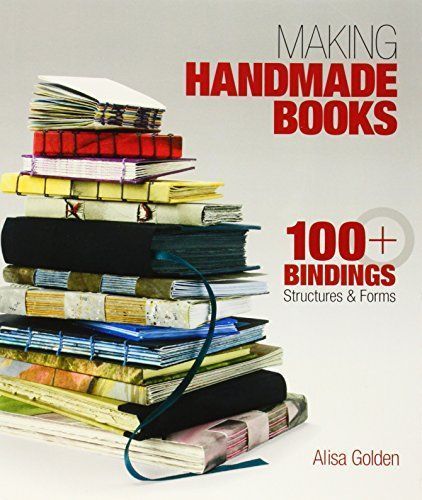Bookbinding for Every Occasion
By Evren Celik, Library Assistant 2
 Crafting won’t solve all your problems, but stabbing something with a needle repeatedly is an easy way to feel less anxious. Unfortunately I can’t follow a pattern to save my life, so for a while I only did embroidery.
Crafting won’t solve all your problems, but stabbing something with a needle repeatedly is an easy way to feel less anxious. Unfortunately I can’t follow a pattern to save my life, so for a while I only did embroidery.
At some point in high school, I ran out of fabric and decided to try embordering paper. This led to the creation of what could generously be called a hand-bound journal, but would more accurately be classified as an abstract paper sculpture. Luckily, learning how to make a book can be a much smoother process if one acknowledges the existence of instruction manuals.
“Making Handmade Books : 100+ Bindings, Structures & Forms” by Alisa J. Golden provides an overview of what bookbinding is, as well as how to do it. It’s targeted at beginners and intended to get you started on projects in less than a day. Golden shares photos of her own work, as well as tidbits and examples from 40 other artists. “Making Handmade Books” allows readers to explore easy materials, practice simple binding, folding, and shape techniques, while also achieving the satisfaction of a finished and usable project.
For a slightly more project-based introduction to bookbinding, Charlotte Rivers’ “Little Book of Bookmaking: Timeless Techniques and Fresh Ideas for Beautiful Handmade Books” is great practice. Rivers shares 21 illustrated tutorials covering a wide variety of stitches and materials. Each tutorial illustrates a few techniques and provides both practical and decorative applications. However, the “Little Book of Bookmaking” isn’t just for beginners. It’s great for anyone looking for an easy to follow introduction to a wide variety of bookbinding styles.
“Making Books and Journals: 20 Great Weekend Projects” by Constance E. Richards showcases books for every occasion from start to finish. Ideas include a wedding album, a shell book, a fruit recipe book, a wire-bound journal, and a heart-shaped book small enough to be a necklace. Some projects like the accordion center fold-out book or the stitched web book with dangles provide instruction on techniques. However, the focus is more on book creation than learning the components.
For intermediate bookmakers interested in themed project ideas check out “Bound : Over 20 Artful Handmade Books” by Erica Ekrem or “Eco Books : Inventive Projects from the Recycling Bin” by Terry Taylor. Each manual showcases ideas grouped by themes and materials.
The main difference between the two manuals is the kind of bookbinding projects they focus on. If you’re looking for a fun way to use up your recyclables, look no further than “Eco Books,” it’s ideal for anyone looking for something to do with a collection of pretty paper, yarn, or other odds and ends. Although the manual includes projects like a corrugated cardboard journal, it mostly focuses on books as art projects inspired by materials you could find around your house. Projects include a leaf book and a photo album made of scrap paper and fabric.
If you’re looking for works of art that you can also write in, Erica Ekrem’s “Bound” is a great choice. Ekrem’s work mainly features books with exposed bindings. The manual is separated into sections titled Vintage, Nature, and Leather, which provide bookbinding ideas centering the named material type. Vintage, for example, shows how to repurpose old book covers, or incorporate photographs of your grandmother into the cover of a photo album. There is a Basics section which explains materials and provides illustrated short explanations of stitches. However, the instructions aren’t as detailed or immediately applicable as the earlier manuals.
For anyone who prefers videos to written and illustrated instructions, check out CreativeBug. Featuring thousands of art and craft videos, CreativeBug can be accessed by scrolling down the main page of our website. The tutorials can also be searched by subject in the library catalog. “Creating a Mixed-Paper Sketchbook” and “Coptic Binding” are my personal favorites. To find them, click the “search” dropdown tab on the catalog homepage, select “advanced”, and enter “bookbinding” and “Creativebug” in the first two search fields.
As a note, many bookbinding manuals list necessary supplies like an awl or binder’s thread. Those are great for making sturdier, more professional looking books. However, if you don’t want to invest in supplies yet (or ever) an embroidery needle and any sturdy thread will do. The first sketchbook I made with printer paper and a sewing kit worked fine for the two years I carried it, though it’s more uneven than anything I would bind now.

